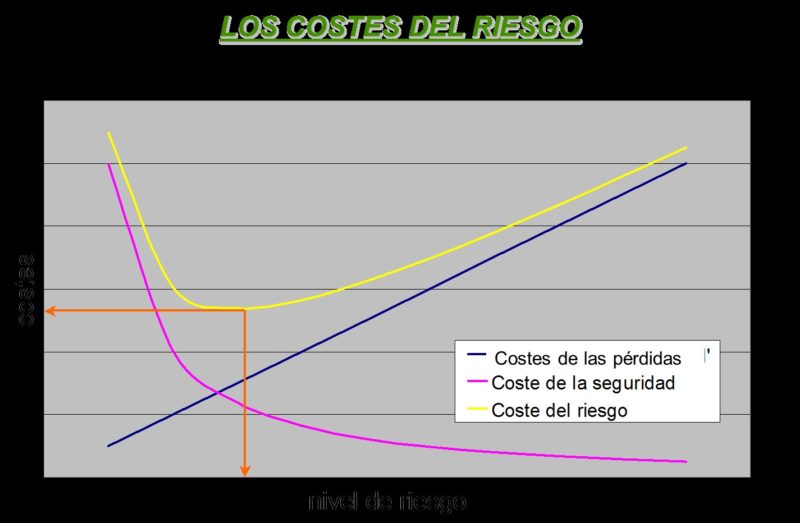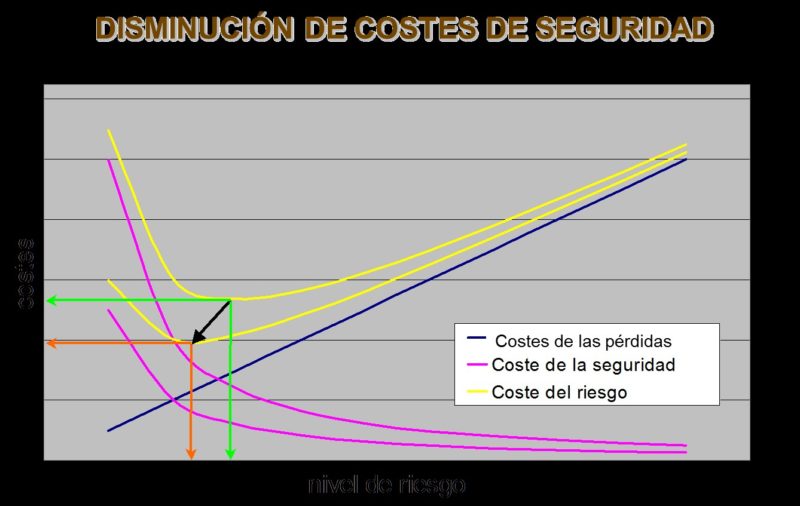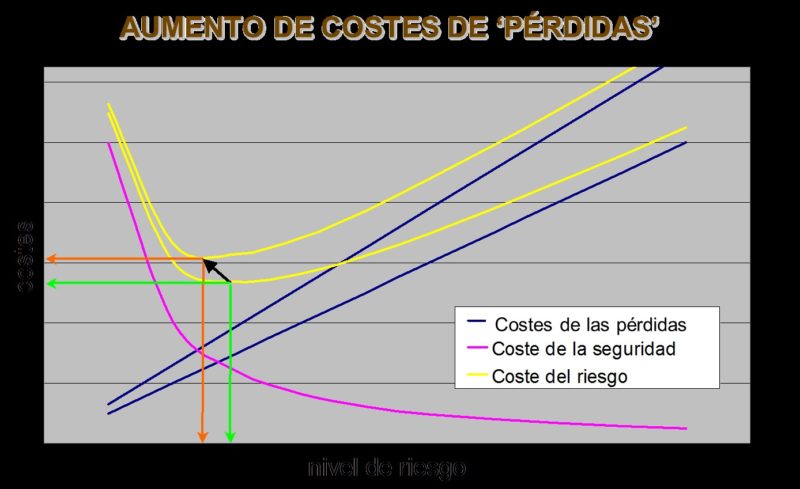admin | 09/01/2019
The appearance of new risks poses new “equations” to be solve to control and minimize their costs. In this article, Pedro Soria García-Ramos, Lead Technician in Engineering at MAPFRE Global Risks, analyzes the variation of factors comprising the cost of risk to ensure it is optimally managed.
Risk management involves minimizing the costs of risk, i.e., optimizing costs to control risk in relation to costs regarding the emergence of the risk.
Variations in the “prices” of the factors, in terms of both prevention and the results of the losses, or even the appearance or emergence of new factors, go together with variation of the optimal point. This variation is applicable in individual management, from the most common to the most complex decisions, business management, or in the management of society itself with respect to actions or legislation carried out by public authorities.
The objective of this article is to underline changes in certain factors in recent years that have moved the optimal point toward positions of greater risk control.
Minimizing the costs of risk
Like many apparently theoretical approaches, the concept of “minimizing the costs of risk” can be difficult to apply practically, although it can be well explained for comprehension.
In this way, in a system where there are risks (circumstances in which damage is possible), optimal risk management would involve minimizing the total cost of risk prevention (generally certain “costs of safety”) and the emergence of risk in the form of loss, (in reality an expectation of loss, with its probabilistic component).

Figure 1: Diagram of the costs of risk and attainment of the optimal point
This approach would mean (assuming that we are starting on the end of the X axis; in other words, no cost of safety, upper cost of losses) that the safety measures are applied as they reduce the costs of losses in the most efficient method with respect to the increase in the cost of safety.
As the decreasing risk levels progress, efficiency will also decrease to the point that it is equal to the marginal cost of safety with the decrease of the costs of losses, i.e., the point at which the costs of risk are minimized.
And these costs of risk, in terms of both costs of safety and costs of losses, will become apparent as financial, emotional, or environmental components.
Depending on their type, these costs may be compensated against each other — financial costs for environmental restoration of a polluted area, for example — or resulting from each other, such as a state of depression resulting from a pollution episode.
Regarding who assumes these costs, a group could also be established between individuals, private companies, and public companies. In other words, it is a group made up of members of society who will ultimately assume those costs. However, similar to the previously mentioned aspects, there is an option to transfer between them (Who pays for the safety measures vs. Who pays for the losses), in which insurance plays an extremely important informative role.
Effects of the variation of the factors comprising the cost of risk
The price reduction of the factors of the costs of safety, as can be seen in Figure 2, would represent both movement in the lower risk levels and reduction of the total cost of risks in the point of equilibrium.

Figure 2: Effect of a decrease in the price of the safety factors
In addition, increases in the price of the factors of the costs of losses will also lead to movement at lower risk levels, but also an increase in the costs of risk. (Figure 3).

Figure 3: Effect of the increase of the costs of losses
In general, we have supported a decrease in the risk level in recent years with both a reduction in the prices of safety factors and a qualitative increase of the losses or their assessment.
In this sense, as circumstances of reduction of costs of safety, the following should be noted:
– International criteria unification, with respect to product safety (e.g., CE marking). The implementation in recent decades of uniform standards of safety and the free movement of products across broad geographic areas in a variety of fields (electrical devices, machines, toys, construction products, etc.) has made it possible to provide the market with safe products in an unprecedented competitive framework, with a very positive impact on society.
– A growth in the culture of safety, meaning that it is easier for individuals and private and public companies to adopt safety measures or positions in a wide variety of fields, ranging from traffic and home safety to occupational safety. Nonetheless, there is still a long way to go in all fields.
– A cost reduction of measurement devices, of the mediums for transmission, storage, and processing of the data generated by them, as they are currently in a transitional phase of a paradigm shift, in which the scope of management of safety or loss prevention is seen as another beneficiary. The supervision and prediction of machine and process safety, help in task performance (such as driving vehicles), based on new disciplines of artificial intelligence, machine learning, image recognition, natural language processing, etc., are starting to provide benefits that were unimaginable just a few years ago. They are expected to bring great results in innumerable fields associated with loss prevention.
In addition, as mentioned, there have also been qualitative changes in the aspects associated with the increase in the costs of losses in a variety of situations, including the following:
– Regulations, often supranational in origin, intended to optimize the costs of risk for society, normally with greater demands on agents of risk in the interest of protecting the patients of risk.
– Greater punitive pressure from legislation as well as increased effectiveness of sanctioning measures. For example, this circumstance is responsible for contributing to a reduction in the field of traffic accidents.
– Higher evaluation of certain vulnerable “assets”, such as the environment, reputation, or human life itself.
– Implementation of advocacy groups and methods of communication that, together with increased awareness in society, expand damage caused to the reputation of both private and public companies.
Conclusion
In conclusion, based on the aforementioned circumstances, it could be considered that the world is progressing towards situations with lower levels of risk; in other words, safer situations. It is expected that these trends will continue for the coming decades.
However, new risks —such as geopolitical risks, risks resulting from new supply chain models, the uncertainty of the impacts of climate change and a decrease in biodiversity, an aging population, the loss of privacy and the vulnerabilities of interconnected IT systems— bring new equations to be optimized by people, entities and governments throughout the world.
In these circumstances, considering premiums as a safety cost for the insured party, the world of insurance must continue to provide adequate coverage of risk for people and companies on the basis of helping the insured party to stabilize the total costs of risk over time, perfecting the estimation mechanisms that can be used to adequately distribute loads.

Pedro Soria García-Ramos
Lead Technician in the Engineering Department at MAPFRE Global Risks
Pedro is an Industrial Engineer and currently manages development of risk assessment methodologies in the Engineering Department at MAPFRE’s Global Risks Unit. He has more than 30 years of experience in the field of engineering and risk control in a variety of disciplines and sectors of operation.





